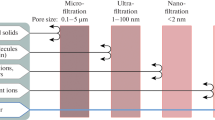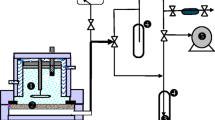Abstract
Organophilic pervaporation is an interesting and promising membrane technology for wastewater treatment, and its topic is always to develop new membrane materials with high separation and application properties. In this study, a new polymeric membrane material-propene/1-octene copolymers (P-co-Os) were synthesized by means of slurry polymerization process under atmospheric pressure using Ziegler–Natta catalyst (MgCl2/TiCl4/AlEt3). The aim was to investigate the correlation between the copolymeric structures and properties. Results from copolymerization showed that at 50 °C, when the mole ratio of Al in AlEt3 and Ti in TiCl4 was 100 and 1-octene concentration was over 0.168 mol/L, random and low-crystalline P-co-Os were obtained. They were demonstrated to have excellent thermal stability and higher mechanical strength than the generally used PDMS membrane. P-co-Os with about 24.6 mol% 1-octene content, its weight loss started at about 400 °C and break strength was 1.7 MPa. Moreover, from pervaporation measurements with chloroform/water mixtures, it was found that an increase of 1-octene content in P-co-Os resulted in a decrease of glass transition temperature (T g), and thus the higher permeate flux but lower selectivity appeared. In general, P-co-Os did exhibit prospects for organophilic pervaporation.









Similar content being viewed by others
References
Peng M, Vane LM, Liu SX (2003) J Hazard Mater 98(1–3):69
Lipnizki F, Hausmanns S, Ten P-K, Field RW, Laufenberg G (1999) Chem Eng J 73(2):113
Feng X, Huang RYM (1997) Ind Eng Chem Res 36(4):1048
Ten RK, Field RW (2000) Chem Eng J 55(8):1425
Wijmans JG, Baker RW (1995) J Membr Sci 107(1–2):1
Wijmans JG (2004) J Membr Sci 237(1–2):39
Schaetzel P, Vauclair C, Nguyen QT, Bouzerar NJ (2004) J Membr Sci 244(1–2):117
Schaetzel P, Vauclair C, Luo G, Nguyen QT (2001) J Membr Sci 191(1–2):103
Peng M, Vane LM, Liu SX (2003) J Hazard Mater 98:69
Han S, Puech L, Law RV, Steinke JHG, Livingston A (2002) J Membr Sci 19(1–2):1
Bell CM, Gerner FJ, Strathmann H (1988) J Membr Sci 36:315
Pereira CC, Rufino JRM, Habert AC, Nobrega R, Cabral LMC, Borges CP (2005) J Food Eng 66(1):77
Nijhuis HH, Mulder MHV, Smolders CA (1993) J Appl Polym Sci 47(12):2227
Xu ZK, Feng LX, Wang DL, Yang SL (1991) Die Makromolekulare Chemie 192(8):1835
Tian XZ, Zhu BK, Jiang X, Xu YY (2005) Chinese J Polym Sci 23(6):623
Fu Z, Xu J, Zhang Y, Fan Z (2005) J Appl Polym Sci 97(2):640
Tian X, Zhu B, Xu Y (2005) J Membr Sci 248(1–2):109
Lovisi H, Tavares MIB, Silva NM, Menezes SMC, Maria LCS, Coutinho FBC (2001) Polymer 42(24):9791
Yan D, Wang W-J, Zhu S (1999) Polymer 40(7):1737
Meng LZ, Gong SL, He YB (2003) Analysis of organic spectrum. Wuhan, Wuhan University Publishing House, China, p 144
Shen D (1982) Application of FTIR methods in macromolecular research. Beijing, Scientific Publishing House, China
Li L, Xiao Z, Zhang Z, Tan S (2004) Chem Eng J 97(1):83
Long RB (1965) Ind Eng Chem Res 4:445
Acknowledgements
This article was supported by the National Natural Science Foundation of China (No. 20704018), the Open Project Program of Key Laboratory of Eco-Textiles, Ministry of Education, China (No. KLET0612) and the Natural Science Initial Research Foundation of Jiangnan University (No. 206000-52210671).
Author information
Authors and Affiliations
Corresponding author
Rights and permissions
About this article
Cite this article
Tian, X., Jiang, X. Propene/1-octene copolymers as a new pervaporative membrane material for wastewater treatment. J Mater Sci 43, 1630–1637 (2008). https://doi.org/10.1007/s10853-007-2296-0
Received:
Accepted:
Published:
Issue Date:
DOI: https://doi.org/10.1007/s10853-007-2296-0




